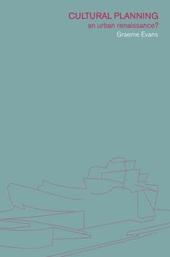
|
Cultural Planning: An Urban Renaissance?
Hardback
Main Details
| Title |
Cultural Planning: An Urban Renaissance?
|
| Authors and Contributors |
Edited by Graeme Evans
|
| Physical Properties |
| Format:Hardback | | Pages:352 | | Dimensions(mm): Height 234,Width 156 |
|
| Category/Genre | The arts -miscellaneous |
|---|
| ISBN/Barcode |
9780415207317
|
| Classifications | Dewey:307.1216 |
|---|
| Audience | | Undergraduate | | Postgraduate, Research & Scholarly | |
|---|
| Illustrations |
10 line drawings, 10 b&w photographs, 15 tables
|
|
Publishing Details |
| Publisher |
Taylor & Francis Ltd
|
| Imprint |
Routledge
|
| Publication Date |
19 July 2001 |
| Publication Country |
United Kingdom
|
Description
The late twentieth century has seen a renaissance in new and improved cultural facilities, from arts and media centres, theatres, museums and galleries to festivals and public art. Cities worldwide have sought to transform their image and economies. Industrial cities have become cultural capitals, such as 'Guggenheim Bilbao'. Glasgow, Barcelona and Baltimore have been emulated by New Jersey and Singapore in regenerating downtown areas through new and upgraded cultural facilities and waterfront developments. Even old world cites such as London, Paris, Berlin and Vienna have created new millennial cultural quarters Using an historic and contemporary analysis, Cultural Planning examines how and why societies have planned for the arts. From its ancient roots in the cities of classical Athenian, Roman and Byzantium empires, to the European Renaissance, public culture has exhibited remarkable continuity in its location and selection of arts facilities and cultural activity, and their role in the form and function of cities. Whether as an extension of welfare provision and human rights, or the creative industries and cultural tourism, the arts are growing elements of urban social and economic development in the post-industrial age. However, the new 'Grand Projects' and cultural resources are highly concentrated, at the cost of both local cultural amenities and a culturally diverse society. Arts audiences have been in decline as cultural venues, museum collections, orchestras and a mobile cultural milieu, have become footloose. Cultural Planning is the first book on the planning of the arts and the relationships between the state arts policy, the cultural economy and city planning. Combining cultural and economic geography with arts and urban policy it uses case-studies and models from Europe, North America and Asia. The book calls for the adoption of a cultural approach to town planning, greater equity in distribution and integration of cultural provision and urban design, in order to prevent the reinforcement of existing geographical and cultural divides.
Reviews"A lucid and wide-ranging primer on the relationship between cultural planning and the development of cities. Strongly recommended for anyone interested in the city as a site of cultural production and consumption.."
-John Hannigan, University of Toronto, author of "Fantasy City
|